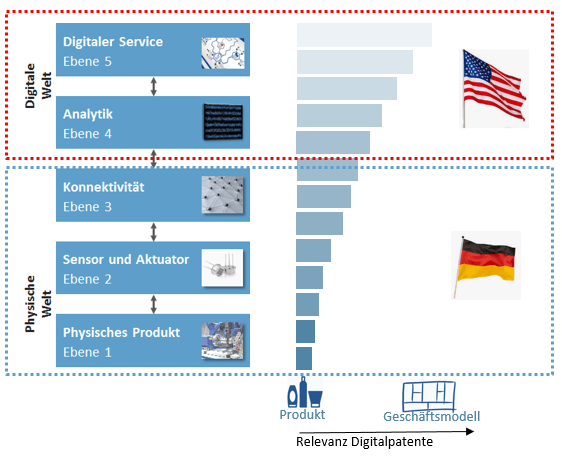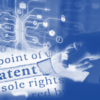Compensation for digital patents with business model relevance
Digital patents are central strategic instruments in digitization. They secure access to profitable positions in digitally transforming eco-systems. Regardless of whether it is 5G, IoT, AI, blockchain, cyber-physical systems or big data applications in all areas of digitization, the question of the patent position plays a decisive role for the access and profitability of business models. The motivation of digital experts is of particular importance for industry. Not only the recognition as inventors, but also the appropriate remuneration for their inventive achievements holds enormous potential to protect digital solutions, apps, products, use cases and business models.
The outstanding position of digital patents becomes clear in the current Patent Index 2019 of the European Patent Office. It is the type of patent that has the fastest growing number of applications and they already account for a good third of all applications at the EPO. A differentiated look at the numbers, origin and content of the registrations reveals the urgent need for action for domestic companies. Of all things, German patent law offers an effective starting point for breaking this trend in favor of German industry.
 The differences, especially to the USA, are not only evident in terms of the bare registration figures. While in Germany a large number of “computer-implemented inventions” – the patent law term – are aimed at the “product-focused” physical world, the focus of US applications, in contrast, is on the digital world (see fig.) e.g. through the use of AI-based analytics, IoT systems, apps or use cases from business models such as the already known patent portfolio for 5G. The reasons for this phenomenon can be found in the previous success factors of the local medium-sized industry. With a high level of innovation, many companies occupy promising niches and serve them with ever new and more sophisticated products whose focus is on optimizing physical properties. Medium-sized companies are following the increasing trend towards digitization with a product-focused logic by gradually equipping their products with the necessary sensors / actuators and connectivity. These cyber-physical systems were developed and produced by R&D based on a classic innovation process.
The differences, especially to the USA, are not only evident in terms of the bare registration figures. While in Germany a large number of “computer-implemented inventions” – the patent law term – are aimed at the “product-focused” physical world, the focus of US applications, in contrast, is on the digital world (see fig.) e.g. through the use of AI-based analytics, IoT systems, apps or use cases from business models such as the already known patent portfolio for 5G. The reasons for this phenomenon can be found in the previous success factors of the local medium-sized industry. With a high level of innovation, many companies occupy promising niches and serve them with ever new and more sophisticated products whose focus is on optimizing physical properties. Medium-sized companies are following the increasing trend towards digitization with a product-focused logic by gradually equipping their products with the necessary sensors / actuators and connectivity. These cyber-physical systems were developed and produced by R&D based on a classic innovation process.
Both the honor of the inventor, the legally prescribed employee inventor remuneration and, last but not least, the integration of the invention into the operational procedures / processes ensure an established practice and so it is not surprising that a large number of computer-implemented inventions with German origin are also registered. At the DPMA, around 10% of all applications now belong to this type of invention.
 At the same time, however, the digitization of products and services opens up extensive new possibilities for the use of patents. The new, digital, value-adding and therefore worthy of protection business objects are based less and less on physical properties, but are more and more digital in nature, such as Digital twins, use cases or superior customer and user journeys. The complementary hardware – the traditional domain of German medium-sized companies – is increasingly becoming a comparatively easily substitutable commodity in this process. Therefore, the economic importance of protecting the digital aspects of products and services continues to grow, especially in industrial, manufacturing German medium-sized companies. The economic value of digital patents is therefore increasing enormously, as can also be seen from the example of Switzerland [Innovation Report CH2048].
At the same time, however, the digitization of products and services opens up extensive new possibilities for the use of patents. The new, digital, value-adding and therefore worthy of protection business objects are based less and less on physical properties, but are more and more digital in nature, such as Digital twins, use cases or superior customer and user journeys. The complementary hardware – the traditional domain of German medium-sized companies – is increasingly becoming a comparatively easily substitutable commodity in this process. Therefore, the economic importance of protecting the digital aspects of products and services continues to grow, especially in industrial, manufacturing German medium-sized companies. The economic value of digital patents is therefore increasing enormously, as can also be seen from the example of Switzerland [Innovation Report CH2048].
When there is a potential (digital) invention, there are obligations for companies and inventors in addition to the patent law, such as the notification of the invention, but also consistently great opportunities:
In addition to the pure implementation, e.g. of the use cases by the digital expert, at the same time assets created, namely prohibition rights, which ideally protect the underlying digital object in a sustainable and legally enforceable manner.
In return for the use and exploitation of the patent, the inventor receives appropriate inventor remuneration, which, depending on the underlying turnover, can quickly turn out to be 5-6 digits with a lucrative and scalable digital business model.
The prospect of participating in company inventions, including the legally prescribed incentives, is in practice enough motivation to develop greater awareness as a digital expert. However, the basis is an understanding of the inventive step in the digitization environment, i.e. what defines a digital invention and how to use established protection options to describe your digital solution. Software “as such” is excluded from patent protection, ie the program code, but its functionality for solving a technical problem can be protected by a patent [example of the German Patent and Trademark Office: display of route navigation]. Since imitation or circumvention is comparatively quick and easy with digital solutions, the specific meaning of the patent with regard to its prohibitive effect for the digital solution must also be taken into account in order to actually achieve the desired competitive advantage.
However, sufficient awareness is also very important for a passive interpretation of patent protection. The misjudgment that “nothing works” on the patent side in a specific digital environment or use case often implies at the same time that no third party can have effective property rights here either. A far-reaching and often expensive misconception, as a recent ruling by the Munich Regional Court against Facebook shows.
The consistently high business model relevance of digital patents not only leads to sensational court judgments, but also has the effect for the inventor that the inventor remuneration in practice is above average.
 The basis for employee inventor remuneration is a trade-off between labor and patent law: In summary, the employer is entitled to the work result from labor law. However, there is a certain tension between this and patent law, since the inventor has the right to the patent. By exercising this right, this right is transferred to the employer and an “appropriate remuneration” is paid to the employee as compensation. The “appropriateness” is not explicitly regulated, however, appropriate suggestions are made in the guidelines for the remuneration of employee inventions. Of central importance is the “inventive value”, for the determination of which the license analogy procedure has prevailed in practice. In this case, an inventor and inventor-individual proportion factor is calculated for the framework conditions for the realization of the invention. The dominant factors, however, are above all the underlying turnover and license rate that would have to be paid to a fictitious third party as the patent holder for their own operational use of such a patent. In contrast to product-oriented patents, however, significantly higher reference values (sales business model / use case vs. sales product) and license rates (e.g. due to high scalability and usually direct applicability of the business model) can be assumed in the digitization environment. As a result, employee inventor remuneration for digital patents is often significantly higher in practice than for “traditional” inventions.
The basis for employee inventor remuneration is a trade-off between labor and patent law: In summary, the employer is entitled to the work result from labor law. However, there is a certain tension between this and patent law, since the inventor has the right to the patent. By exercising this right, this right is transferred to the employer and an “appropriate remuneration” is paid to the employee as compensation. The “appropriateness” is not explicitly regulated, however, appropriate suggestions are made in the guidelines for the remuneration of employee inventions. Of central importance is the “inventive value”, for the determination of which the license analogy procedure has prevailed in practice. In this case, an inventor and inventor-individual proportion factor is calculated for the framework conditions for the realization of the invention. The dominant factors, however, are above all the underlying turnover and license rate that would have to be paid to a fictitious third party as the patent holder for their own operational use of such a patent. In contrast to product-oriented patents, however, significantly higher reference values (sales business model / use case vs. sales product) and license rates (e.g. due to high scalability and usually direct applicability of the business model) can be assumed in the digitization environment. As a result, employee inventor remuneration for digital patents is often significantly higher in practice than for “traditional” inventions.
There is a great opportunity for companies to integrate digital experts into invention. It is important not to develop digital solutions independently of patent knowledge and then want to protect them. In the case of digital objects, it is rather necessary to consider the property of the ability to be protected from the start and to shape this analogous to security or stability as an essential characteristic and requirement of the solution. The key word here is “Patentability by Design” analogous to “Secure by Design” and the method used is: IP design.



